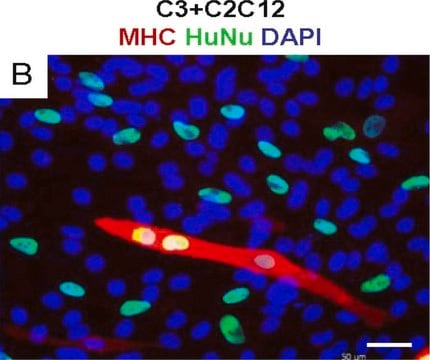MAB1276
Anti-Nuclei & Chromosomes Antibody, histone H1 protein, clone 1415-1
clone 1415-1, Chemicon®, from mouse
Sinónimos:
Anti-H1.4, Anti-H1E, Anti-H1F4, Anti-H1s-4, Anti-HIST1H1E, Anti-RMNS, Anti-dJ221C16.5
About This Item
Productos recomendados
biological source
mouse
Quality Level
antibody form
purified antibody
antibody product type
primary antibodies
clone
1415-1, monoclonal
species reactivity
human, rat
manufacturer/tradename
Chemicon®
technique(s)
ELISA: suitable
immunocytochemistry: suitable
immunohistochemistry: suitable (paraffin)
western blot: suitable
isotype
IgG2a
NCBI accession no.
UniProt accession no.
shipped in
wet ice
target post-translational modification
unmodified
Gene Information
human ... H1-1(3024)
Specificity
Stains nuclei of all human cell types and also stains chromosomes diffusely in metaphase cells. Nuclear staining in interphase cells is intense and diffuse. Antibody reacts with rat cells {Bendeck, 2001}.
Immunogen
Application
Physical form
Analysis Note
POSITIVE CONTROL:
Human tonsil
Legal Information
Not finding the right product?
Try our Herramienta de selección de productos.
Storage Class
12 - Non Combustible Liquids
wgk_germany
WGK 2
flash_point_f
Not applicable
flash_point_c
Not applicable
Certificados de análisis (COA)
Busque Certificados de análisis (COA) introduciendo el número de lote del producto. Los números de lote se encuentran en la etiqueta del producto después de las palabras «Lot» o «Batch»
¿Ya tiene este producto?
Encuentre la documentación para los productos que ha comprado recientemente en la Biblioteca de documentos.
Nuestro equipo de científicos tiene experiencia en todas las áreas de investigación: Ciencias de la vida, Ciencia de los materiales, Síntesis química, Cromatografía, Analítica y muchas otras.
Póngase en contacto con el Servicio técnico







